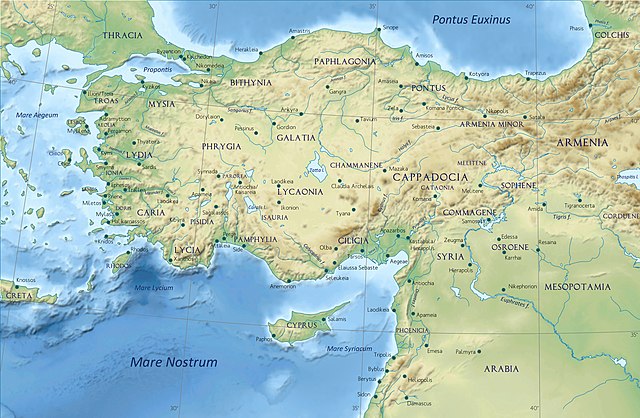Top Qs
Timeline
Chat
Perspective
List of ancient Anatolian peoples
From Wikipedia, the free encyclopedia
Remove ads
This is a list of ancient Anatolian peoples who inhabited most of Anatolia (or Asia Minor). "Anatolian" here has the meaning of an Indo-European branch of peoples that lived in the Anatolia Peninsula or Asia Minor, although not all ancient peoples that dwelt in this Peninsula were Indo-Europeans. These peoples were speakers of the Anatolian branch (or subfamily) of the Indo-European language family.[1]
This article has multiple issues. Please help improve it or discuss these issues on the talk page. (Learn how and when to remove these messages)
|
Remove ads
Ancestors




- Proto-Indo-Europeans (Proto-Indo-European speakers)[2]
- Proto-Anatolians (Indo-European) (Proto-Anatolian speakers)[3][4][5][6]
Remove ads
Hittites (Nesitic / Central Anatolians)
- Hittites / Nesites[7][8][9] (𒉈𒅆𒇷 - Nesumines)
- Cappadocians? / Leucosyri? (according to Herodotus, Cappadocians and Leucosyri were the same people[10] - Cappadocians was the Persian name and Leucosyri the Greek name) (Cappadocians also inhabited the West Pontus that originally was part of Cappadocia)[11]
- Amiseni? (inhabited Themiscyra district in West Pontus)
- Cases? / Kases?
- West Pontians?
- Cappadocians? / Leucosyri? (according to Herodotus, Cappadocians and Leucosyri were the same people[10] - Cappadocians was the Persian name and Leucosyri the Greek name) (Cappadocians also inhabited the West Pontus that originally was part of Cappadocia)[11]
Luwics (Southern Anatolians)
- Luwians[12][13][14]
- Cataonians (possibly assimilated by the Cappadocians in the Classical Age) (in the Bronze Age and early Iron Age, Cataonia was part of the Neo-Hittite kingdoms who were Luwian speaking; however in Classical Antiquity, Strabo states that although they were distinct peoples, they spoke the same language as the Cappadocians)[15]
- Cilicians[16][17]
- Danuna[18][19] - they dwelt in the "Land of the Danuna" (they may have been the inhabitants of Adana, Adaniya or Ataniya city and region, in Cilicia and also they may have been the people called Denyen by the ancient Egyptians, one of the Sea peoples)
- Clitae - recorded by Tacitus to have lived in the Taurus Mountains range during the reign of Archelaus of Cappadocia, primarily on two hills named Cadra and Davara[20]
- Isaurians[21][22]
- Lycaonians[23][24]
- Philistines? (they may have been the people called Peleset by the ancient Egyptians, one of the Sea peoples)[25][26]
- Southwest
- Carians[27][28][29]
- Leleges[30][31][32]
- Pamphylians (Non-Hellenics)
- Pisidio-Sidians
- Pisidians / Pamphylians (Pamphylians, on the coast, and Pisidians, in the inland, were the same people and spoke the same language, the difference was that Anatolian Pamphylians were more Greek influenced since Iron Age) (there was an Anatolian Pamphylian dialect, part of the Pisidian language, and a Pamphylian Greek dialect, part of Ancient Greek, depending on the degree of Hellenization)
- Sidians (in Side region)
- Solymoi / Solymi (according to Strabo, this was the older name of the Milyans) (they may have been or not the same people as the Lycians)[33][34]
- Telchines?
- Lasonians? (Ancient Greek: Λασονίων, romanized: Lasoníōn) - part of the 2nd Taxation district of the Persian Empire[39]
- Cabalians? (Ancient Greek: Καβαλέων, romanized: Kabaléōn) - part of the 2nd Taxation district of the Persian Empire[40]
- Hytennians? (Ancient Greek: Ὑτεννέων, romanized: Hutennéōn) - part of the 2nd Taxation district of the Persian Empire[41]
Remove ads
Western Anatolian?
Related to but not part of Luwics
Palaics (Northern Anatolian)
Possible Anatolian (Indo-European) peoples
- Mysians?[55][56] (possibly they were more related to the Phrygians, a non Anatolian Indo-European people, and therefore they were possibly not an Anatolian Indo-European people, Mysia was also known as Phrygia Hellespontica, however they probably had a mixing with an Anatolian people closer to the Lydians, which would explain some statements by ancient authors such as Strabo when he stated that Mysian language was, in a way, a mixture of the Lydian and Phrygian languages)
- Milatai? / Milatae?
Remove ads
See also
References
Wikiwand - on
Seamless Wikipedia browsing. On steroids.
Remove ads